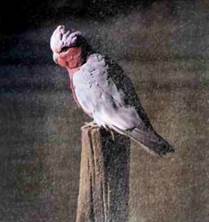Australia. Wildlife. Unique animal life
At one time, all the world's continents were part of one huge land mass. The region that is now Australia became separated from this land mass about 200 million years ago, and as a result, the animal life of Australia developed differently from that of other continents. For example, marsupials — animals with pouches—are Australia's most unusual and famous creatures.

A female koala and her young rest in a forked tree. The koala, a native of Australia's eastern forests, was near extinction in the 1920's. Today, as a protected species, this charming creature has been making a slow comeback
Unique animal life. Most mammals give birth to relatively well developed offspring, but Australia's marsupials give birth to tiny, poorly developed offspring. The marsupial newborn undergoes most of its development while attached to one of its mother's nipples in a pouch called the marsupium. Kangaroos, koalas, wallabies, and wombats are marsupials. Australia has about 150 species of marsupials, all of which have pouches.
The platypus and the echidna, found only in Australia, are the only mammals in the world that hatch their young from eggs. Platypuses live in long burrows that they dig in the banks of streams. Except for females with their young, each platypus lives in its own burrow. Platypuses can walk on land as well as swim, and they use their bills to scoop their food from the bottom of streams.
Australia also has about 700 species of native birds. They include the world's only black swans and about 60 kinds of cockatoos, parakeets, and other parrots. The emu, a large, flightless bird, has long legs for running and stands 5-1/2 feet (1.7 meters) high. The kookaburra, one of Australia's best-known birds, nests in tree holes and has a call that sounds like a loud laugh.

Kangaroos are the symbol of Australia to people throughout the world. The kangaroo family includes about 50 species. They range in size from the huge red and gray kangaroos, which stand about 6 feet (1.8 meters) tall, to tiny creatures smaller than a domestic cat

Emus cannot fly, but their long legs can carry them to speeds of nearly 30 miles (50 kilometers) per hour. They are found everywhere in the country except the rain forests

Galah parrots are pink and gray cockatoos that live in many inland areas of Australia. Many people keep these parrots as pets. Galahs eat the seeds of grasses and other plants
Plant life. Two kinds of native plants dominate Australia's landscape. Varieties of acacias and eucalyptuses are the most common shrubs in dry areas and the most common trees in moist areas. Acacias, which Australians call wattles, bear their seeds in pods. Australia has about 700 species of acacias, many with brightly colored flowers.
Eucalyptuses, or eucalypts, as the Australians call them, are the most widespread plants in the country. Most species have narrow, leathery leaves that contain a fragrant oil. Scrubby eucalyptuses cover large areas of Australia's hot, dry interior. Eucalyptus trees, known as gum trees or gums, are the tallest trees in the country and among the tallest in the world. Some types of eucalyptus may grow to a height of 330 feet (100 meters). At one time, the eucalyptus grew only in Australia and on a few islands to the north. But these trees have been planted in California, Hawaii, and in many other warm areas.
Australia has thousands of wildflowers. Many are desert species whose seeds lie buried in the ground until heavy rain brings them to life. These plants can make deserts look like gardens right after a desert rain. The waratah, a tall shrub found only in Australia, grows under trees in open forests and bears large, bright-red flowers. Its name comes from an Aboriginal word meaning seen-from-afar.
To a great extent, Australia's wildlife has suffered at the hands of the European settlers, who have greatly changed the environment since they arrived in the 1700's. Many wildlife species became extinct in the 1800's, and many others have been lost since then. Today, at least 40 Australian animals are endangered. Many others are protected.
Date added: 2023-02-07; views: 734;
